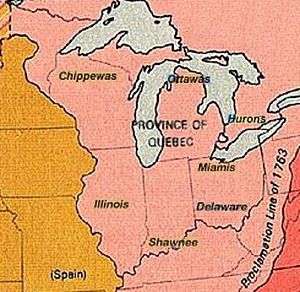Western Confederacy
The Western Confederacy, also known as Western Indian Confederacy, was a loose confederacy of North American Natives in the Great Lakes region following the American Revolutionary War. The confederacy, which had its roots in pan-tribal movements dating to the 1740s, came together in an attempt to resist the expansion of the United States into the Northwest Territory after Great Britain ceded the region to the United States in the Peace of Paris (1783). The resistance resulted in the Northwest Indian War (1785–1795), which ended with the U.S. victory at the Battle of Fallen Timbers.
Although many of the native peoples had fought in the Revolutionary War as British allies, Great Britain made no mention of their allies in the Treaty of Paris. According to Joseph Brant, a Mohawk chief who was one of the early architects of the confederacy, the British had "sold the Indians to Congress." The confederacy first came together in 1786 at a conference at the Wyandot town of Upper Sandusky, with the intention of forming a common front in dealing with the Americans.
Members of many different American Indian tribes were involved in the Western Confederacy. The confederacy was sometimes known as the "Miami Confederacy;" U.S. officials overestimated the influence and numerical strength of the Miami tribe within the confederation.
Because most tribes were not centralized political units at the time, involvement in the confederacy was usually on a village rather than a tribal basis. The confederacy consisted of members of the following tribes:

- Council of Three Fires
- Iroquois Confederacy
- Seven Nations of Canada
- Wabash Confederacy (Wea, Piankashaw, and others)
- Illini Confederacy
- Wyandot
- Mississaugas
- Menominee
- Shawnee
- Lenape
- Miami
- Kickapoo
- Kaskaskia
- Chickamauga Cherokee (or "Lower Cherokee")
- Upper Muscogee
References
- Allen, Robert S. His Majesty's Indian Allies: British Indian Policy in the Defense of Canada. Toronto: Dundurn, 1992. ISBN 1-55002-184-2.
- Dowd, Gregory Evans. A Spirited Resistance: The North American Indian Struggle for Unity, 1745–1815. Baltimore: Johns Hopkins University Press, 1992. ISBN 0-8018-4609-9.
- Sugden, John. Blue Jacket: Warrior of the Shawnees. Lincoln: University of Nebraska Press, 2000. ISBN 0-8032-4288-3.
- Sword, Wiley. President Washington's Indian War: The Struggle for the Old Northwest, 1790-1795. Norman and London: University of Oklahoma Press, 1985. ISBN 0-8061-1864-4 (hardcover); ISBN 0-8061-2488-1 (paperback).
- Tanner, Helen Hornbeck, ed. Atlas of Great Lakes Indian History. Norman: University of Oklahoma Press, 1987. ISBN 0-8061-2056-8.
- Tanner, Helen Hornbeck. "The Glaize in 1792: A Composite Indian Community." Ethnohistory 25, no. 1 (Winter 1978), pp. 15–39. Also available online from JSTOR (account required)
- White, Richard. The Middle Ground: Indians, Empires, and Republics in the Great Lakes Region, 1650–1815. Cambridge University Press, 1991. ISBN 0-521-42460-7.